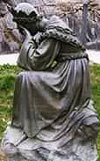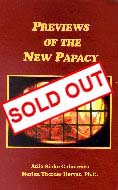Progressivism in the Church
Church Revolution in Pictures
Photo of the Week
/520-Cross01.jpg)
The strange pectoral cross of the Bishop of Rome
Above left, you see the pectoral cross of Card. Jorge Bergoglio when he was Archbishop of Buenos Aires; at right, his cross after he was elected Pope or Bishop of Rome, as he insists on being called. Several things are strange about these crosses that invite speculation:
1. It is not uncommon for religious authorities to leave off the image of Our Lord Crucified on their pectoral crosses. However, even when they do so, implicitly it is clear that their crosses symbolize the Crucified Christ, the Redeemer who by His death canceled the guilt of Original Sin and re-opened the road of salvation. Further, the fact that those prelates wear their crosses on their chests, close to their hearts, means that they are proud disciples of the Crucified, ready to shed their blood for Him.
The cross of Pope Bergoglio makes a point of denying this truth. On his cross he pictures the figure of the Good Shepherd, as if he were saying, "I do not believe in Original Sin and, therefore, there was no redemption from it." This would correspond to the progressisivt theory that pretends Original Sin was a myth invented by the Church to explain a primitive stage of mankind in the universal evolution.
2. The shape of the cross is not that of a traditional cross. The crossing of the two beams is not defined, but spread out. It does not look like a symbol of the torment He suffered, but a simple metal plaque with a sculpture. Again, it sends the message that Pope Francis is not comfortable with being a representative of Our Lord Crucified.
3. On the plaque a dove representing the Holy Spirit is also shown descending from heaven over the flock and the Good Shepherd. One does not find any mention in Scripture of a scene where the Holy Spirit comes down directly over the flock. More likely it is an allusion to the Protestant-Pentecostal theory that claims God does not need the Catholic Hierarchy, but gives His orientation to the flock by a direct action of the Holy Spirit.
No need to say that it also implicitly denies the role of the Pope, who according to Catholic Faith, is the Vicar of Christ on earth, who is the one called to govern and teach the flock.
4. The metal of the cross is a cheap one. The different colors of the two crosses suggest that Bergoglio has more than one cross with the same symbols in different metals. His cross as a cardinal, at left, looks like a blend of brass; the second one he wears as Pope, at right, looks like either a blend of iron or pewter.
In both cases, what is clear is his rejection of the gold and precious stones that normally are used for pectoral crosses. It is a symbolic affirmation that the Church must not be rich. This is part of the miserablist thesis affirming that, after the Church left the Catacombs, she wrongly imitated the world as she bestowed on her dignitaries precious symbols of their missions. By using this cross Pope Francis symbolically affirms that he wants to wipe out this conception and return to the poverty of the times of the Catacombs, before the Church took on these "sins."
This is not a novel or original position. Throughout the History of the Church heretics of diverse origins defended precisely the same thesis. They include the Manicheans in the third century, Mazdah in Persia and the followers of Paulicanism in Armenia in the sixth; Bishop Claudius of Turin and Bishop Agobard of Lyons in the ninth.
Multiple Gnostic sects burgeoned in the Middle Ages, such as the Friends of God in Byzantium, the Dragovitsna church in Bulgaria, both predecessors of the Cathar movement. One of the Cathar branches was called the Poor Men of Lyons, founded by Peter Waldo, which generated the Waldensians and the Albigensians.
The Cathar current defending a Miserablist Church also included movements like the Communiati, the penitential order of the Umiliati, the Patarini, the Apostolic Brethren and the Fraticelli, who enjoyed the support of Michael of Cesana and William of Occam. Many sects that preceded the Pseudo-Reformation are also included in this current, such as the followers of Wycliffe in England, Jan Hus in Bohemia, Savonarola and Campanella in Italy, and Luther and Thomas Munzer in Germany.
These are some of the heretics who defended the same thing that Progressivism upholds regarding the riches of the Church. Now, Pope Francis brings these ideas to center stage, after the way was prepared by the other conciliar Popes. Thus, a completely different face for the Church is starting to be shaped.
5. The fact that Pope Francis did not choose a new cross, but kept the one he had as Archbishop, seems to reveal that he does not consider the dignity of a Pope to be essentially higher than that of a Bishop. This also is confirmed by his insistence on being called Bishop of Rome, instead of Pope.
/520-Cross02.jpg)












